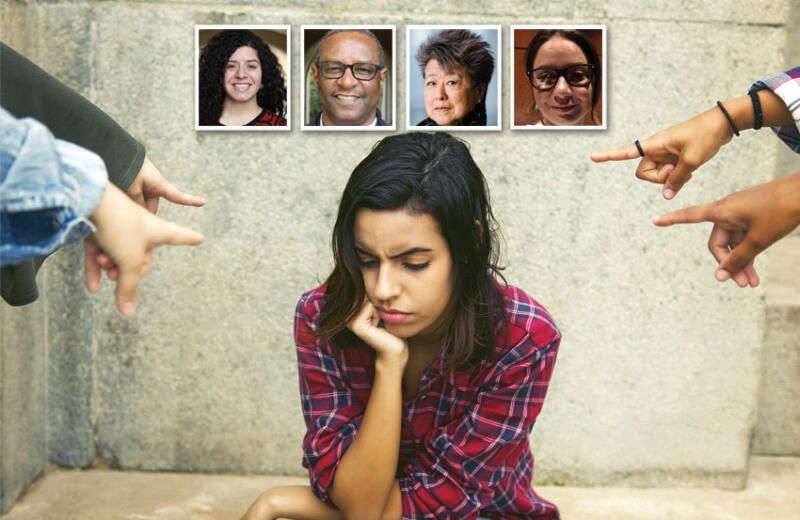Why Women are Primary Target of Xenophobic Hate
(Above, Inset: l-r): Basima Sisemore, researcher for the Global Justice Program at the Othering & Belonging Institute at UC Berkeley; Elsadig Elsheikh, Director of the Global Justice Program at the Othering & Belonging Institute at UC Berkeley; Helen Zia, AAPI activist, author, and journalist; and Irene de Barraicua, Director of Operations, Lideres Campesinas. (Siliconeer/EMS)
The violence visited on Asian women, especially elders; a new report on anti-Muslim hate crimes documents that women, not men, are the primary targets; as women make up a growing percentage of migrants from Latin America, they too are on the receiving end of xenophobic assaults. This is particularly evident for Latino women who work in agriculture – Why women bear the brunt of xenophobic hate?
At an Ethnic Media Services briefing, Oct. 8, speakers – Basima Sisemore, researcher for the Global Justice Program at the Othering & Belonging Institute at UC Berkeley; Elsadig Elsheikh, Director of the Global Justice Program at the Othering & Belonging Institute at UC Berkeley; Helen Zia, AAPI activist, author, and journalist; and Irene de Barraicua, Director of Operations, Lideres Campesinas – explored a phenomenon that has become increasingly evident as hate crimes have soared against immigrants.
Basima Sisemore shared the results of her study.
“Islamophobia through the eyes of Muslims – This is the first national study to ask Muslim Americans their perceptions and experience in relation to Islamophobia and how Islamophobia impacts them. It was conducted in all 50 states and had 1,123 respondents. U.S. Muslims participated in the survey. 1,800 people actually submitted responses but due to the criteria for eligibility it was narrowed down to 1,123 U.S. Muslims.
“Islamophobia exists in the United States. It’s not new, and it certainly predates the events of 9-11. Islamophobia didn’t start as a result of 9-11. However, to quantify the impacts of Islamophobia, and to quantify just how pervasive Islamophobia is, and its impacts, are quite shocking and notably the findings of how Islamophobia impacts women, and how women bear the brunt of Islamophobia, this wasn’t necessarily surprising to us, and this is something that has been very well documented within the United States, France, Belgium, as well as other European countries,” said Sisemore.
“The findings were of course unsettling, nonetheless. Women have higher visibility as Muslims due to their distinctive dress that identifies them as Muslim – the Hijab, or Naqab, or some other form of dress,” said Sisemore.
“The liberal and imperialist feminisms play a role and feed into the false and dangerous narrative of Muslim women as being oppressed. Muslim women are seen as being in need of liberation and being saved from violent and oppressive Muslim men, which is a very dangerous narrative that we saw play out in the invasions of Iraq and Afghanistan. As that discourse and narrative was put forth, as a means to garner public support for invasion, and to also put forward the narrative of White saviorism.
“It’s important to understand that Islamophobia exists both at the individual level and at the institutionalized or institutional or structural level. Islamophobia can be perpetrated by individuals in terms of individual acts of violence which has been seen throughout the decade, which is not uncommon, and is something that unfortunately happens in the United States.
The other thing to note is how Islamophobia has been institutionalized within the United States through federal measures and state policies, like the travel ban, or the Muslim ban,” said Sisemore.
“According to a survey, the population of U.S. Muslims is around 3.5 million people. Muslim-Americans have been living in the United States since the inception of the nation. It goes back to this slave trade when the Africans arrived or were brought to the United States. About 20 percent of the population of African slaves were Muslims, according to some research data. Islamophobia has been used as a political tool for demagogues and white supremacists and we saw that in clarity during 2016 presidential elections,” said Elsadig Elsheikh.
“In a country that prides itself on protecting religious beliefs and identity, Islamophobia makes it hard for Muslims to carry on with their own religious identity like anybody,” said Elsheikh. “The younger population between age of 18 and 29, four out of ten try to hide their religious identity,” said Elsheikh.
“Most recently, when we saw troops leave Afghanistan, there were primarily men on the tarmac attempting to flee, essentially reinforcing the stereotype of women being left behind and that that played out for about a week and contributed to a stereotype of the Muslim culture. Muslim Americans blame media for misrepresentation or unfair representation of Muslims.
“I really reject completely, this idea, that Muslim women are oppressed in Islamic societies,” said Elsheikh.
In the past two years, Chinese American and Asian American Pacific Islander communities have been reporting a tidal wave of racist and xenophobic incidents clearly related to the COVID 19 pandemic.
“I’d like to refer you to the stopaapihate.org website that has a number of reports on the more than nine thousand incidents, that have been reported to their one website from March 2020 to June 2021. Among their reports they showed, that of those nine thousand incidents, more than two to one, more than 66 percent of those attacks, have been against Asian American women. Girls in K-12, young Asian American females. This is just one website. It’s clearly an undercount.
“Within this past year, we’ve seen killings in Atlanta, Georgia, that targeted Asian American women who work at spas,” pointed Helen Zia.
“Just to give a little bit of the framework, why we know that xenophobic attacks, racist attacks against people of color and immigrants, are based on this idea of a ‘foreign invader’ to the ‘Make America White Again’ world. That there is an otherness, that is about rendering whole groups of people as second class, as being less than human, and many of these supremacist groups just come right out and say that people of color are sub-human; that they’re not human and in addition, we layer on gender-based attacks against women and so that also subjugates women as human beings, making women expendable, disposable. When you combine them, the impact is that the lives of women of color, the lives of Asian American women, the lives of immigrant women, are facing multiple jeopardy for being just who they are,” said Zia.
“They may even face a stigma within their own community for something happening to them,” added Zia.
“Olympians who are women, or girls, weren’t even treated with respect, or have their reports of sexual assault taken seriously, it’s no wonder, Asian American women and women of color in general, hesitate to report at all, when they’ve been made so invisible and powerless in America. It’s part of the systemic inequalities and inequities.
“Two months after Penthouse magazine ran a pornographic so-called story about Asian American women featured pictorially in positions of bondage and looking like they were dead, an eight-year-old Chinese American girl was found raped murdered lynched hanging from a tree in North Carolina, in a position that duplicated one that was in that magazine spread, and that was not treated seriously,” said Zia.
“There have been many reports about young Asian immigrant women and international students who have been attacked by serial sexual assaulters, rapists seeking out Asian American or Asian women. There was a college fraternity at Ohio state university that ran an ethnic sex challenge that listed a checklist of different ethnicities of women that their fraternity brothers should sexually assault or have sex with. There were gang rapes of Asian women then. The list goes on,” said Zia.
Irene de Barraicua spoke about the discrimination that Latina women, immigrants in particular, face in the U.S. and their countries of origin as well. “Latina and indigenous women, agricultural workers, in particular immigrants coming from Mexico, Central and South America, faced violence in various forms in their countries of origin. Many escaped violence from intimate partners, from society, from exploitation in the workplace, and many have fallen victim to labor and sexual trafficking. They came to the U.S. seeking refuge.
“A network of women farm worker leaders began in the 80’s by a group of women known as Mujeres Mexicanas in Coachella, Calif. The purpose of this was to address the issues that Latina women face – discrimination, being often sexualized and dehumanized, in the school districts, in their own work sites, as farm workers.
“This network of women farm workers has made a difference for many, lifting their voices and having them speak up,” said Barraicua.
Commenting on the U.S-China tensions, Zia said, “It will make the lives of Asians in America worse… We’ve gone through a long period in America of isolating, targeting, scapegoating, and harming people who are different… The U.S-China policies right now and for the foreseeable future are going to continue this. Asian-American women as the perceived vulnerable population will continue.”


